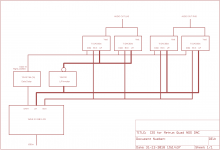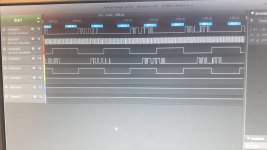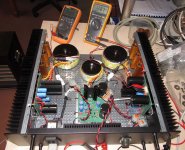The chassis is connected to safety earth through the socket connector, it's 3 wires in on the trafo. Probably a bit hard to see.I don't see a connection of the chassis to safety earth. This would be a safety issue. Fix this first.
Where is the green wire from the transformer going? Is this a shield for the transformer? If yes, I'd connect the green wire to the chassis of the DDDAC.
I wasn't sure how to connect the output since I use unbalanced. I did read through a lot of posts and thought it should be like this since I got 2,7v dc between pos and common.
The chassis is connected to safety earth through the socket connector, it's 3 wires in on the trafo. Probably a bit hard to see.
I wasn't sure how to connect the output since I use unbalanced. I did read through a lot of posts and thought it should be like this since I got 2,7v dc between pos and common.
Connecting the output RCA connectors properly to common instead of negative out will likely fix your hum problem. Let us know how it goes.
Is there anyone out there using the DDDAC with Rpi/Isolator/Kali combo? If yes, what is your observation on the sound signature when compared to WaveIO? What sort of power supply do yo use to power these devices?
From whatever I have fiddled around, the Rpi/Isolator/Kali combo sounds very cold and lifeless. The juice is missing!! Going back to WaveIO, it sounds more robust, thicker.
I want to know if I am not doing something correctly with Isolator/Kali setup as there are glorious reviews online on the same.
From whatever I have fiddled around, the Rpi/Isolator/Kali combo sounds very cold and lifeless. The juice is missing!! Going back to WaveIO, it sounds more robust, thicker.
I want to know if I am not doing something correctly with Isolator/Kali setup as there are glorious reviews online on the same.
Is there anyone out there using the DDDAC with Rpi/Isolator/Kali combo? If yes, what is your observation on the sound signature when compared to WaveIO? What sort of power supply do yo use to power these devices?
From whatever I have fiddled around, the Rpi/Isolator/Kali combo sounds very cold and lifeless. The juice is missing!! Going back to WaveIO, it sounds more robust, thicker.
I want to know if I am not doing something correctly with Isolator/Kali setup as there are glorious reviews online on the same.
Yes, I've done that. Just search this thread for a few interesting stories. I believe there are different versions/batches of the Kali, and not all work the same. If they work well with the DDDAC, you will get better sound from an RPi+Kali than with the WaveIO. With a bit of luck you can also make the Kali work with the WaveIO (to reclock the WaveIO).
Even if a given Kali board works perfectly, you need to be aware that there is a slight time delay between the I2S input to the Kali and the I2S output to the DDDAC. This is not fun when using your audio system while watching movies.
I have moved to the HifiBerry, which just works and gives the same sound quality than the Kali (at least according to my ears).
I’m using a W4S Recovery reclocker between my Mac mini USB out and the WaveI/O. The Recovery seems to add a bit of solidity and resolution to the sound signature.
The reclocking is done on the USB signal? I'd think it's more effective on the I2S.
The reclocking is done on the USB signal? I'd think it's more effective on the I2S.
Yes, you are then supplying a clean re clocked signal to the WaveI/O over a short USB cable.
It is really easy to screw up the I2S signal timing as is seen by all the issues around the Kali implementations. I really haven’t had enough listening time with my DDDac to test all the various combinations of tweeks for sound. I had the Recovery so it went in the system and that’s as far as I’ve got with tweaking.
I’d still like to try more boards, a buffer stage, and the Rpi setup but it won’t be TIL sometime in the new year. I got bogged down in a home reno and need to get that done before any more DIY an happen.
Connecting the output RCA connectors properly to common instead of negative out will likely fix your hum problem. Let us know how it goes.
Thank you all for the input!
It got a lot better, got rid of the 50hz! But now it sounds like a more quiet 100hz. Probably half the volume of the 50hz or even lower, easy to hear 2-3 meters from the speakers. Also some high frequency but that could be fixed with caps?
Attached a photo from Spectroid, might help?

Thank you all for the input!
It got a lot better, got rid of the 50hz! But now it sounds like a more quiet 100hz. Probably half the volume of the 50hz or even lower, easy to hear 2-3 meters from the speakers. Also some high frequency but that could be fixed with caps?
Attached a photo from Spectroid, might help?

this looks a dropping voltage at rectifier frequency - so why not check the 8 Volt at the dac chip.
Oscilloscope: Is it flat? do you have an AC signal addition on top? (I expect a kind of square wave)
or with your FFT analyzer: just look at the spectrum of the 8 Volt...
let us know
Thanks for the input!
After some fiddling with the oscilloscope I figured out that it definitely was a problem caused by the power supply. Adding some caps before the dac really did well!
Now there is still some high frequency noise around 12khz, please see attached photo.

After some fiddling with the oscilloscope I figured out that it definitely was a problem caused by the power supply. Adding some caps before the dac really did well!
Now there is still some high frequency noise around 12khz, please see attached photo.

Thanks for the input!
After some fiddling with the oscilloscope I figured out that it definitely was a problem caused by the power supply. Adding some caps before the dac really did well!
Now there is still some high frequency noise around 12khz, please see attached photo.

Good to hear the remote diagnostics worked
now all is fine, enjoy the music !!
I2S for Metrum Quad NOS DAC using DDDac ideas
Hi Gents,
The DDDac project gave me a lot of inspiration and understanding of Digital Audio. Many thanks to Doede...
Currently I'm using two good old Metrum Quad DAC's and one of them was extreme sensitive for switching impulses of light bulbs, solder irons etc. via the SPDIF input with muting of the audio signal as result. It drove me mad so I made the discission to try I2S as these signals have a higher level.
I bought a Wave IO from Lucien and made some conversion as in the DDDac.
The Metrum is using Texas Instruments 16-bit DAC chips in NOS mode so in my understanding I have to convert 32bit I2C from the Wave IO to 16 bit right justified data. I took 2x 74VHC164 to delay 15+(1) bits. After some reverse enginering of the Metrum I noticed that the L/R clock was inverted for one channel and for me it was quite easy to re-use this circuit. Cutting traces in a multi layer PCB is impossible and lifting tiny IC pins isn't my hobby so I gave it a try. In the drawing you can see the block diagram. It's a bit quick and dirty. Excuse me for that.
Currently I'm listening to the modified Metrum and it sounds good to me. It's not sensitive for switching impulses anymore so I can enjoy the music.
There are still a few questions on my mind... I don't use a 24 bit buffer for the second channel. It's solved by inverting the L/R I think. Are there any timing issues doing it this way?
I'm not a "bit level" specialist.
I also added a picture of my 10 euro data-analyzer. I did stream just one channel test tone via Spotify and when I count clock pulses it seems to fit. At channel 0 is the original 32bits data stream. At channel 1 the BCK. At ch.2 and 4 the L/R selection and at ch.3 the delayed 16bit RJ data stream.
Any suggestion?
Happy New Year...Johan
Hi Gents,
The DDDac project gave me a lot of inspiration and understanding of Digital Audio. Many thanks to Doede...
Currently I'm using two good old Metrum Quad DAC's and one of them was extreme sensitive for switching impulses of light bulbs, solder irons etc. via the SPDIF input with muting of the audio signal as result. It drove me mad so I made the discission to try I2S as these signals have a higher level.
I bought a Wave IO from Lucien and made some conversion as in the DDDac.
The Metrum is using Texas Instruments 16-bit DAC chips in NOS mode so in my understanding I have to convert 32bit I2C from the Wave IO to 16 bit right justified data. I took 2x 74VHC164 to delay 15+(1) bits. After some reverse enginering of the Metrum I noticed that the L/R clock was inverted for one channel and for me it was quite easy to re-use this circuit. Cutting traces in a multi layer PCB is impossible and lifting tiny IC pins isn't my hobby so I gave it a try. In the drawing you can see the block diagram. It's a bit quick and dirty. Excuse me for that.
Currently I'm listening to the modified Metrum and it sounds good to me. It's not sensitive for switching impulses anymore so I can enjoy the music.
There are still a few questions on my mind... I don't use a 24 bit buffer for the second channel. It's solved by inverting the L/R I think. Are there any timing issues doing it this way?
I'm not a "bit level" specialist.
I also added a picture of my 10 euro data-analyzer. I did stream just one channel test tone via Spotify and when I count clock pulses it seems to fit. At channel 0 is the original 32bits data stream. At channel 1 the BCK. At ch.2 and 4 the L/R selection and at ch.3 the delayed 16bit RJ data stream.
Any suggestion?
Happy New Year...Johan
Attachments
Time to have another go at a dual 16 Tent board DDDAC.
I have started with the power supply, and using the original DDDAC power supply circuit, I have had some PCB`s made with big power traces, Mundorf 10000uf smoothing capacitors, TIP142 transistor, DSA70C200HB rectifier and Nichicon BT series long life capacitors as I keep the Dac powered up continually.
Runs at 5.1A constant with 50ºC power transistor temp and 46ºC at 4.08A so I am not short of power and will be reliable.
I now have to convince Doede to make me some main boards with extra buffering
I have started with the power supply, and using the original DDDAC power supply circuit, I have had some PCB`s made with big power traces, Mundorf 10000uf smoothing capacitors, TIP142 transistor, DSA70C200HB rectifier and Nichicon BT series long life capacitors as I keep the Dac powered up continually.
Runs at 5.1A constant with 50ºC power transistor temp and 46ºC at 4.08A so I am not short of power and will be reliable.
I now have to convince Doede to make me some main boards with extra buffering
Attachments
Time to have another go at a dual 16 Tent board DDDAC.
I have started with the power supply, and using the original DDDAC power supply circuit, I have had some PCB`s made with big power traces, Mundorf 10000uf smoothing capacitors, TIP142 transistor, DSA70C200HB rectifier and Nichicon BT series long life capacitors as I keep the Dac powered up continually.
Runs at 5.1A constant with 50ºC power transistor temp and 46ºC at 4.08A so I am not short of power and will be reliable.
I now have to convince Doede to make me some main boards with extra buffering
Nice to see you flounder time for this Alex ! Just email me, you have my email, and we will discuss what we could do to get this little pig flying. ;-)
Pretty newby here. I’ve build a single board dddac with a Sjöström psu and a rpi/allo isolator/hifiberry as i2s streamer. I’m using the Cinemag 15/15b transformers and a Pass B1 Buffer with an impedance of 86kohm.
It sounds great with much details but I keep missing low frequencies. First tried 10k as the total impedance on the secondary witch sounded way to ‘thin’. With total load of 15k it sounds better but still missing some lows. Someone tips? I don’t have fancy equipment to see what’s happening. Thanks!
It sounds great with much details but I keep missing low frequencies. First tried 10k as the total impedance on the secondary witch sounded way to ‘thin’. With total load of 15k it sounds better but still missing some lows. Someone tips? I don’t have fancy equipment to see what’s happening. Thanks!
Pretty newby here. I’ve build a single board dddac with a Sjöström psu and a rpi/allo isolator/hifiberry as i2s streamer. I’m using the Cinemag 15/15b transformers and a Pass B1 Buffer with an impedance of 86kohm.
It sounds great with much details but I keep missing low frequencies. First tried 10k as the total impedance on the secondary witch sounded way to ‘thin’. With total load of 15k it sounds better but still missing some lows. Someone tips? I don’t have fancy equipment to see what’s happening. Thanks!
why would you need a buffer? Did you try without ?
- Home
- Source & Line
- Digital Line Level
- A NOS 192/24 DAC with the PCM1794 (and WaveIO USB input)


